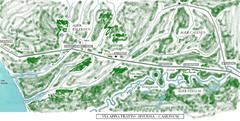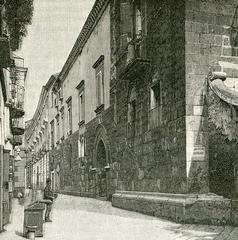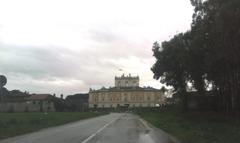Visiting Hours, Tickets, and History of Via Ponte Romano in Capua, Italy
Date: 01/08/2024
Welcome to our comprehensive guide on Via Ponte Romano, a significant historical site in Capua, Italy. Discover its rich history, cultural significance, and everything you need to know for an unforgettable visit.
Capua, a city steeped in history and cultural significance, offers a unique journey through time for visitors. From its Etruscan origins in the 9th century BC to its role as a critical hub in the Roman Empire, Capua’s rich historical tapestry is evident in its architecture and landmarks. One of the most remarkable sites in Capua is the Via Ponte Romano, an ancient Roman bridge that showcases the engineering prowess of its time. Though the original bridge was destroyed during World War II, the modern reconstruction preserves its historical essence, making it a must-visit for history enthusiasts and casual travelers alike (Italy This Way). This comprehensive guide will provide you with detailed information on visiting hours, ticket prices, historical insights, and travel tips to ensure an enriching experience when exploring Capua and its iconic Roman Bridge.
Table of Contents
- Introduction
- Historical Background
- Exploring Via Ponte Romano
- Visitor Information
- FAQ
- Conclusion
- Call to Action
Introduction
Capua, an ancient city with a rich tapestry of historical significance, offers visitors a journey through time. From its origins in the 9th century BC to its modern-day reconstruction, Capua is a destination that history enthusiasts and casual travelers will find equally fascinating. This guide provides comprehensive information, including visiting hours, ticket prices, and historical insights to help you plan your visit to Capua.
Historical Background
Origins and Early History
The origins of Capua date back to the 9th century BC, with archaeological evidence indicating continuous habitation from this period through the Roman era. The initial settlement was established by the Etruscans, and its early history is primarily known through the necropolis, the oldest part of which dates back to the mid-9th century BC. This necropolis was located in the north-western part of the city and showed early contact with the Ancient Greek world (Italy This Way).
Roman Era
Capua’s significance grew exponentially during the Roman era. By the end of the 3rd century BC, it had become the most important center in Campania, characterized by intense construction activities and specialized agricultural production, particularly of vines. The Romanization of Capua was completed by 59 BC when it was controlled by a colony of veterans who had fought with Julius Caesar. This period saw considerable public and private construction, significantly altering the town’s layout (Italy This Way).
The Roman Bridge
One of the most notable constructions from this era is the Roman Bridge, known locally as Ponte Romano. Although the current structure is a modern reconstruction, the original bridge was a crucial part of the Roman consular road, Via Appia, which connected Rome to Brindisi. The bridge was destroyed by bombing in 1943 during World War II but remains a significant historical landmark (Reggia di Caserta Unofficial).
Medieval Period
The medieval history of Capua is marked by its destruction and subsequent rebuilding. The ancient city was destroyed by the Saracens in 841 AD, leading the survivors to seek refuge on the Palombara hill near Sicopoli. However, this settlement was also destroyed, prompting the Lombard count Landone I to establish the new Capua in 856 AD on a bend in the Volturno River. This new location was strategically significant as it guarded the bridge over the Volturno, which was part of the Via Appia (Reggia di Caserta Unofficial).
Renaissance and Beyond
Between the Middle Ages and the Renaissance, Capua was a principality several times and served as an important stronghold for Naples, the capital of the Kingdom. The city saw significant architectural developments during this period, including the construction of the Castle commissioned by Charles V in 1542. Despite extensive damage from World War II bombings, the castle retains much of its original grandeur and is one of the main monuments of the city (Reggia di Caserta Unofficial).
The Port of Capua and the Towers of Frederick II
At the end of the Roman Bridge, visitors can find the remnants of the Towers of Frederick II, which were part of the famous Capua gate. This gate, constructed between 1233 and 1240, was not merely an entrance to the city but a monumental gateway to the Kingdom of Sicily. The Swabian emperor Frederick II played an active role in its design, suggesting the political and ideological themes for its sculptural decorations. Although the gate was demolished in 1557 during the renovation of the city walls by the Spaniards, the bases of the two towers remain, and the sculptures that adorned it are preserved in the Campano Museum (Reggia di Caserta Unofficial).
The Campano Museum
The Campano Museum, inaugurated in 1874 and renovated in 2010, houses a vast collection of artifacts from antiquity, including statues and frescoes from local sites. One of the most notable collections is that of the votive statues of Mothers, found in a sanctuary dedicated to the Italic goddess of fertility, Matuta. The museum is located in the historic Antignano Palace, which dates back to the 9th century and incorporates the remains of the Lombard-age church, San Lorenzo ad Crucem (Reggia di Caserta Unofficial).
Modern Capua
Today, Capua is a city that blends its rich historical past with modern life. The Roman Bridge, although a reconstruction, continues to be a symbol of the city’s enduring legacy. The bridge and its surrounding areas are popular tourist attractions, offering a glimpse into the city’s ancient and medieval history. Visitors can explore the remains of the ancient structures, visit the Campano Museum, and walk along the historic Via Appia, experiencing the layers of history that have shaped this remarkable city (Reggia di Caserta Unofficial).
Exploring Via Ponte Romano
Ancient Origins
Via Ponte Romano, located in Capua, Italy, is a testament to the engineering prowess of ancient civilizations. Capua, known as ‘haughty Rome’ by Cicero, was a significant city in Roman times, reaching its zenith around the 2nd century BC. The city’s strategic location and its integration into the Roman road system made it a crucial hub for trade and military movements. The Via Ponte Romano, part of this extensive network, played a vital role in connecting Capua with other major cities and regions.
Etruscan and Samnite Influence
Before the Romans, Capua was occupied by the Etruscans and later the Samnites. These early inhabitants laid the groundwork for the city’s infrastructure, including the initial pathways that would later be expanded and formalized by the Romans. The Etruscans, known for their advanced engineering skills, likely contributed to the early development of the road system that would become Via Ponte Romano.
Roman Expansion and Engineering
The Roman era marked a period of significant expansion and enhancement of Capua’s infrastructure. The Via Ponte Romano was constructed using advanced engineering techniques, including the use of durable materials like stone and concrete. This road not only facilitated trade and military logistics but also symbolized the Roman commitment to connectivity and control over their vast empire. The road’s construction involved meticulous planning and labor, reflecting the Romans’ dedication to creating enduring structures.
Economic and Military Importance
Via Ponte Romano was more than just a road; it was a lifeline for the economic and military activities of ancient Capua. The road enabled efficient movement of goods, troops, and information, contributing to the city’s prosperity and strategic importance. The connectivity provided by Via Ponte Romano allowed Capua to thrive as a commercial center, attracting merchants and traders from across the Roman Empire.
Cultural and Social Impact
The road also had a profound cultural and social impact on Capua. It facilitated the exchange of ideas, cultures, and traditions, enriching the city’s social fabric. The movement of people along Via Ponte Romano brought diverse influences to Capua, contributing to its vibrant cultural scene. The road was a conduit for the spread of Roman culture, language, and customs, helping to integrate Capua more deeply into the Roman world.
Architectural Marvel
Via Ponte Romano stands as an architectural marvel of its time. The road’s construction involved the use of advanced engineering techniques, including the creation of arches and bridges to traverse challenging terrains. These structures not only served practical purposes but also showcased the aesthetic sensibilities of Roman architects. The road’s design and construction reflect the Romans’ ability to blend functionality with beauty, creating enduring landmarks that continue to inspire awe.
Visitor Information
Visiting Hours
Most historical sites in Capua, including the Campano Museum and the Castle of Charles V, are open to visitors from 9:00 AM to 6:00 PM, Tuesday through Sunday. Entrance fees vary, with the Campano Museum charging approximately €5 for adults, while children under 12 can enter for free. Tickets for the Castle of Charles V are available at the entrance, with guided tours offered upon request.
Travel Tips
- Best Time to Visit: The best time to visit Capua is during the spring and autumn months when the weather is mild and the tourist crowds are smaller.
- Accessibility: Most historical sites in Capua are wheelchair accessible, with ramps and elevators available at the Campano Museum and other major attractions.
- Nearby Attractions: Visitors can also explore nearby attractions such as the Royal Palace of Caserta, the ancient amphitheater of Santa Maria Capua Vetere, and the picturesque town of Casertavecchia.
- Special Events: Capua hosts various cultural events throughout the year, including historical reenactments, music festivals, and local fairs. Check the city’s official website for the latest event schedule.
Guided Tours and Photography Spots
Guided tours are available for most historical sites, offering deeper insights into Capua’s rich history and architecture. Popular photography spots include the Roman Bridge, the Castle of Charles V, and the scenic views along the Volturno River. Don’t miss the chance to capture the intricate details of the Towers of Frederick II and the statues in the Campano Museum.
Accessibility
Via Ponte Romano is accessible to visitors of all ages. However, the ancient road’s uneven surfaces and occasional steep sections may pose challenges for those with mobility issues. Wearing comfortable walking shoes is recommended, and visitors should be prepared for some physical exertion. For those with limited mobility, certain sections of the road may be more accessible, and it’s advisable to check with local tourist information centers for specific accessibility details.
Nearby Attractions
While visiting Via Ponte Romano, take the opportunity to explore other historical sites in Capua. The Mithraeum, an ancient sanctuary dedicated to the god Mithras, offers a glimpse into the religious practices of the time. The Campanian Amphitheatre, the second largest in Italy after the Colosseum, is another must-visit site. The Archaeological Museum provides a comprehensive overview of Capua’s history, from the Bronze Age to the Roman era.
Local Cuisine
No visit to Capua is complete without sampling the local cuisine. The region is known for its delicious traditional dishes, including pasta, seafood, and pastries. Local restaurants and cafes offer a variety of options, from casual dining to fine dining experiences. Be sure to try regional specialties such as ‘mozzarella di bufala’ (buffalo mozzarella) and ‘sfogliatella’ (a flaky pastry filled with sweet ricotta).
Souvenirs and Shopping
Visitors can also explore local markets and shops for unique souvenirs. Handcrafted items, local wines, and traditional ceramics make for memorable keepsakes. The markets often feature products made by local artisans, providing an opportunity to support the local economy and take home a piece of Capua’s rich cultural heritage.
Safety Tips
While Capua is generally a safe destination for tourists, it’s always wise to take basic precautions. Keep an eye on your belongings, especially in crowded areas, and be aware of your surroundings. It’s also a good idea to carry a map or have a navigation app on your phone to help you find your way around the city. If you’re traveling with children, ensure they stay close and are aware of safety guidelines.
Photography
Photography enthusiasts will find plenty of opportunities to capture stunning images of Via Ponte Romano and its surroundings. The ancient road, with its historical structures and scenic views, provides a picturesque backdrop for photos. Remember to respect any signage regarding photography restrictions, especially in areas of archaeological significance.
FAQ
- What are the best times to visit Via Ponte Romano? The best times to visit are during the spring (April to June) and autumn (September to October) months when the weather is mild and pleasant.
- Are there guided tours available? Yes, guided tours are available and can provide valuable insights into the history and significance of Via Ponte Romano.
- Is Via Ponte Romano accessible to people with mobility issues? Some sections may pose challenges due to uneven surfaces, but certain areas are more accessible. Check with local tourist information centers for details.
- Are there any nearby attractions worth visiting? Yes, notable nearby attractions include the Mithraeum, Campanian Amphitheatre, and the Archaeological Museum.
Conclusion
Capua’s historical background is a tapestry of ancient Etruscan roots, Roman grandeur, medieval resilience, and Renaissance splendor. Each era has left its mark on the city, making it a fascinating destination for history enthusiasts and casual visitors alike. Plan your visit to Capua to explore its rich history, enjoy its architectural beauty, and experience the enduring legacy of this remarkable city.
Call to Action
Download our mobile app for more travel tips and updates. Check out our related articles on other historical sites in Italy, and follow us on social media for the latest news and events.


